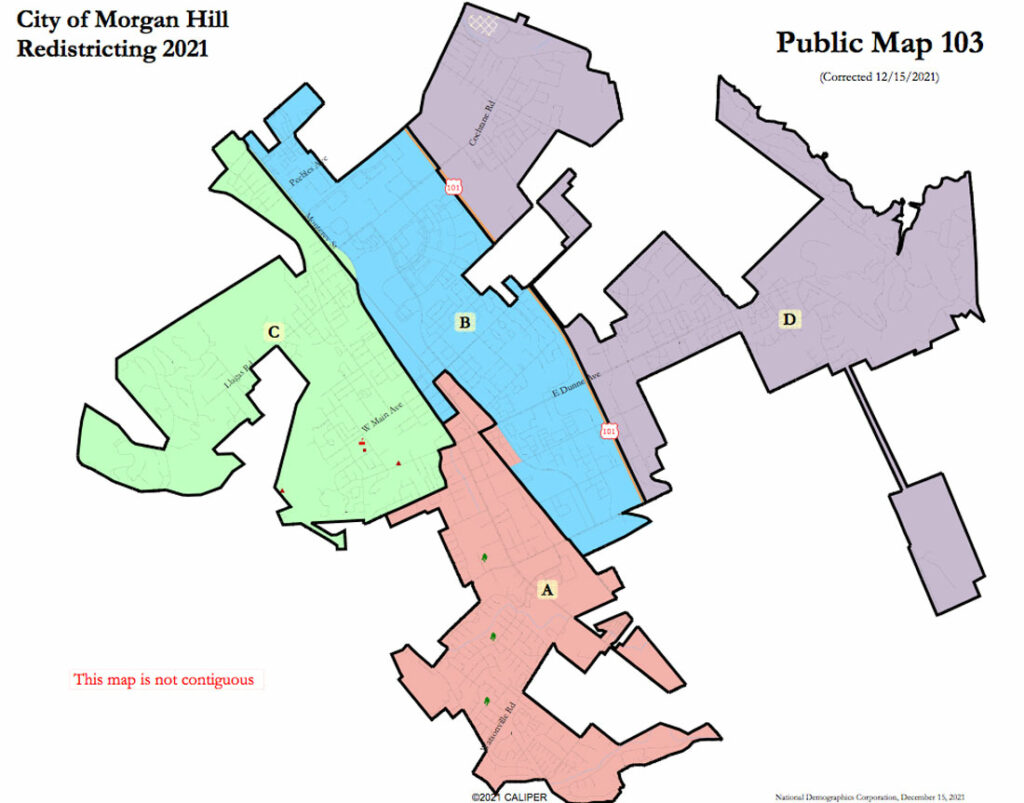Morgan Hill’s city attorney has recused himself from a lawsuit filed by former Mayor Steve Tate earlier this month over city council redistricting. Defending the city from the legal action instead is a local lawyer who had threatened to sue the council if it didn’t accept the redistricting plan that is the subject of the recent lawsuit.
In an April 20 closed session, the city council gave City Attorney Don Larkin the authority to withdraw from the lawsuit that alleges the local body violated the California Fair Maps Act by adopting the redistricting map known as “Map 103.” Faced with the need to hire outside counsel to defend the city’s redistricting decision, Larkin reached out to attorney Armando Benavides to represent the city in the lawsuit, which was filed April 11 in Santa Clara County Superior Court.
A hearing is scheduled for May 9, where a judge will determine if the adopted Map 103 complies with the state redistricting law. The lawsuit was filed by attorney Christopher Skinnell on behalf of his clients Tate, Swanee Edwards and Brian and Kathy Sullivan.
Benavides said he and the city’s co-counsel, Morris Baller, filed a response to the lawsuit April 26, but the filing was not readily available at press time.
“The city council deliberated and ultimately made a choice they felt was in the best interests of Morgan Hill, and selected a map they believed did comply with the (Fair Maps) Act,” Benavides said. “So that’s what we’re litigating. We’re supporting the legal decision made by the majority of the council.”
Larkin said he requested to withdraw from the case because the lawsuit amplifies his repeated advice to the council in recent months that Map 103 does not comply with the Fair Maps Act, a state law that regulates electoral redistricting and sets out criteria for new district boundaries.
“It would have been difficult for me to argue against my own position,” Larkin said in an email.
He added that under the Rules of Professional Conduct for Attorneys, he felt it was “appropriate to withdraw under the circumstances.”
Benavides has been a vocal advocate for Map 103—which largely preserves current council districts—throughout the recent decennial redistricting process that started with public meetings and workshops in late 2021.
The council voted 3-2 on March 2 to adopt Map 103, with Councilmembers John McKay and Gino Borgioli dissenting. At that meeting, Benavides told the council before it voted that he would sue the city if they adopted any redistricting map other than Map 103. That threat prompted Mayor Rich Constantine to cast the deciding vote in favor of the now-litigious map.
But Larkin and the city’s redistricting consultant—National Demographics Corporation—had warned the council that it would face a lawsuit if it approved Map 103 because it does not comply with a requirement in the Fair Maps Act that districts be geographically contiguous. District D in the adopted map consists of two regions in east Morgan Hill that are separated by a patch of unincorporated county land.
Benavides has argued that Map 103 is in compliance because the state law, which was adopted in 2019, gives the council discretion to declare the districts contiguous.
Following the March 2 decision was a demand letter from Skinnell urging the council to reconsider its decision. The council did so on April 6, where it again voted 3-2 to uphold Map 103.
A few days later, Skinnell filed the current lawsuit.
“Despite the plain, unambiguous requirement of (the Fair Maps Act) that ‘to the extent practicable, council districts shall be geographically contiguous,’ the council adopted a district map that is not geographically contiguous to the extent practicable,” reads the lawsuit. “In so doing, it has disregarded the explicit advice of the city attorney, the city’s special redistricting counsel, the city’s redistricting consultant and many others.”
Cities with elective council districts—as well as other government bodies—are required by state and federal law to review their boundaries every 10 years based on changes in population and demographics presented in the U.S. Census.
The mayor’s seat, as well as the council Districts B (currently occupied by Yvonne Martinez Beltran) and D (occupied by John McKay) are up for election in the November balloting. The qualifying period for candidates begins in July. Larkin has previously said the courts would likely expedite the redistricting dispute due to its potential impact on the upcoming election.
The mayor is elected at large by voters throughout the city, and Mark Turner is the only candidate who has officially declared his intent to run for the office so far. Constantine is running for Santa Clara County District 1 Supervisor.









